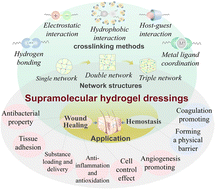Supramolecular hydrogels for wound repair and hemostasis
Abstract
The unique network characteristics and stimuli responsiveness of supramolecular hydrogels have rendered them highly advantageous in the field of wound dressings, showcasing unprecedented potential. However, there are few reports on a comprehensive review of supramolecular hydrogel dressings for wound repair and hemostasis. This review first introduces the major cross-linking methods for supramolecular hydrogels, which includes hydrogen bonding, electrostatic interactions, hydrophobic interactions, host–guest interactions, metal ligand coordination and some other interactions. Then, we review the advanced materials reported in recent years and then summarize the basic principles of each cross-linking method. Next, we classify the network structures of supramolecular hydrogels before outlining their forming process and propose their potential future directions. Furthermore, we also discuss the raw materials, structural design principles, and material characteristics used to achieve the advanced functions of supramolecular hydrogels, such as antibacterial function, tissue adhesion, substance delivery, anti-inflammatory and antioxidant functions, cell behavior regulation, angiogenesis promotion, hemostasis and other innovative functions in recent years. Finally, the existing problems as well as future development directions of the cross-linking strategy, network design, and functions in wound repair and hemostasis of supramolecular hydrogels are discussed. This review is proposed to stimulate further exploration of supramolecular hydrogels on wound repair and hemostasis by researchers in the future.

- This article is part of the themed collections: Materials Horizons most popular articles 2024, Recent Review Articles and #MyFirstMH


 Please wait while we load your content...
Please wait while we load your content...